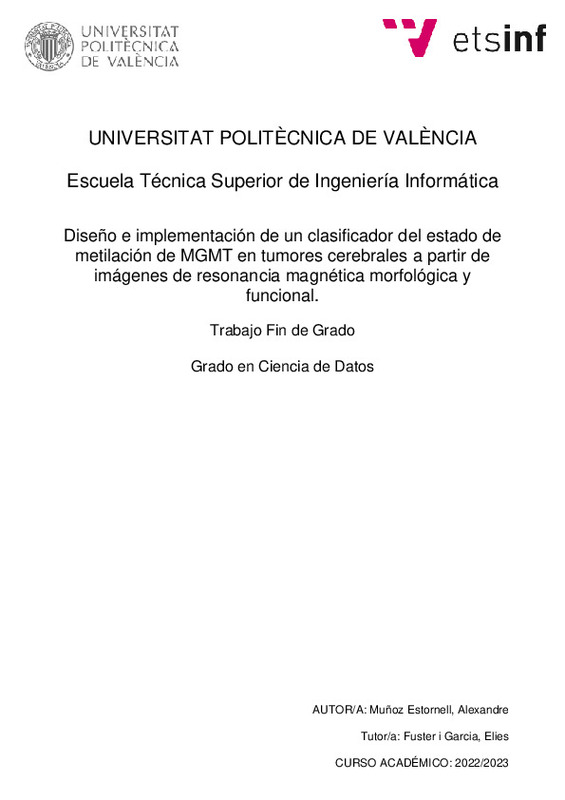|
Resumen:
|
[ES] La metilación del gen MGMT (O6-metilguanina-ADN metiltransferasa) es un
biomarcador clave en la predicción del pronóstico y la respuesta al tratamiento en pacientes con
glioblastoma, el tumor cerebral primario más ...[+]
[ES] La metilación del gen MGMT (O6-metilguanina-ADN metiltransferasa) es un
biomarcador clave en la predicción del pronóstico y la respuesta al tratamiento en pacientes con
glioblastoma, el tumor cerebral primario más común y agresivo. Las técnicas habituales para
detectar la metilación del gen incluyen PCR en tiempo real o secuenciación de bisulfito, métodos
invasivos que requieren tejido tumoral. El estudio propone un enfoque innovador para el análisis
de imágenes médicas que combina técnicas de procesamiento de imágenes, aprendizaje profundo
y transferencia de aprendizaje para desarrollar un modelo de clasificación capaz de detectar y
evaluar el estado de metilación de MGMT en pacientes con glioblastomas. La solución propuesta
se basa en la extracción de características morfológicas y funcionales de las imágenes de RM, que
son relevantes para la identificación del estado de metilación del gen MGMT.
Se llevó a cabo una revisión exhaustiva de la literatura para identificar y seleccionar
características relevantes y métodos de clasificación previamente utilizados en el campo de la
oncología tumoral. Para validar la efectividad y precisión del modelo se utilizó un conjunto de
imágenes de RM de pacientes con glioblastomas, incluyendo información sobre el estado de
metilación del promotor del gen MGMT obtenida a través de técnicas de biología molecular. Se
evaluó la solución utilizando métricas estándar como la precisión y el área bajo la curva ROC
(AUC).
Los resultados obtenidos indican que el clasificador desarrollado es capaz de predecir con cierto
éxito el estado de metilación del gen MGMT en tumores cerebrales a partir de imágenes de RM
morfológica, ofreciendo un enfoque no invasivo y potencialmente más accesible para la
evaluación de este importante biomarcador en pacientes con glioblastoma. Además, se discuten
las limitaciones del estudio y se sugieren futuras investigaciones para mejorar la precisión y la
aplicabilidad clínica del clasificador propuesto.
[-]
[EN] The methylation of the MGMT gene (O6-methylguanine-DNA methyltransferase) is a
key biomarker in predicting prognosis and treatment response in patients with glioblastoma, the
most common and aggressive primary brain ...[+]
[EN] The methylation of the MGMT gene (O6-methylguanine-DNA methyltransferase) is a
key biomarker in predicting prognosis and treatment response in patients with glioblastoma, the
most common and aggressive primary brain tumor. Standard techniques for detecting gene
methylation include real-time PCR or bisulfite sequencing, invasive methods that require tumor
tissue. This study proposes an innovative approach to medical image analysis that combines
image processing techniques, deep learning and transfer learning to develop a classification model
capable of detecting and evaluating the methylation status of MGMT in patients with
glioblastomas. The proposed solution is based on the extraction of morphological and functional
features from MRI images, which are relevant for the identification of the MGMT gene
methylation status.
An extensive literature review was conducted to identify and select relevant features and
classification methods previously used in the field of tumor oncology. To validate the
effectiveness and accuracy of the model, a set of MRI images from the patients with glioblastoma
was used, including information about images from patients with glioblastomas was used,
including information on the methylation status of the MGMT gene promoter obtained through
molecular biology techniques. The solution was evaluated using standard metrics such as
accuracy or area under the ROC curve (AUC).
The results obtained indicate that the developed classifier is able to predict the methylation status
of the MGMT gene in brain tumors with some success using morphological MRI images, offering
a non-invasive and potentially more accessible approach for the assessment of this important
biomarker in patients with glioblastoma. In addition, the study’s limitations are discussed, and
future research is suggested to improve the accuracy and clinical applicability of the proposed
classifier.
[-]
|







